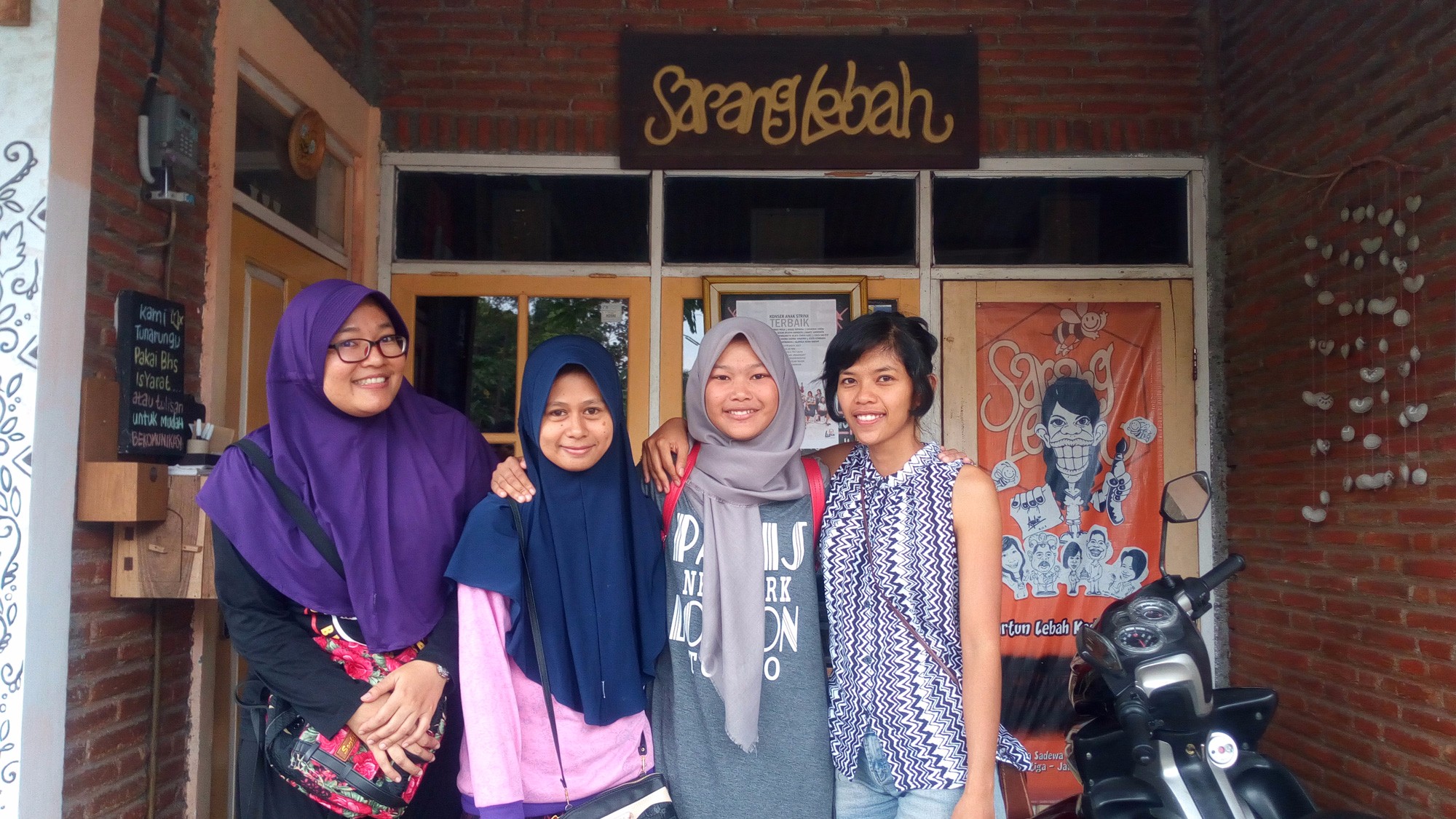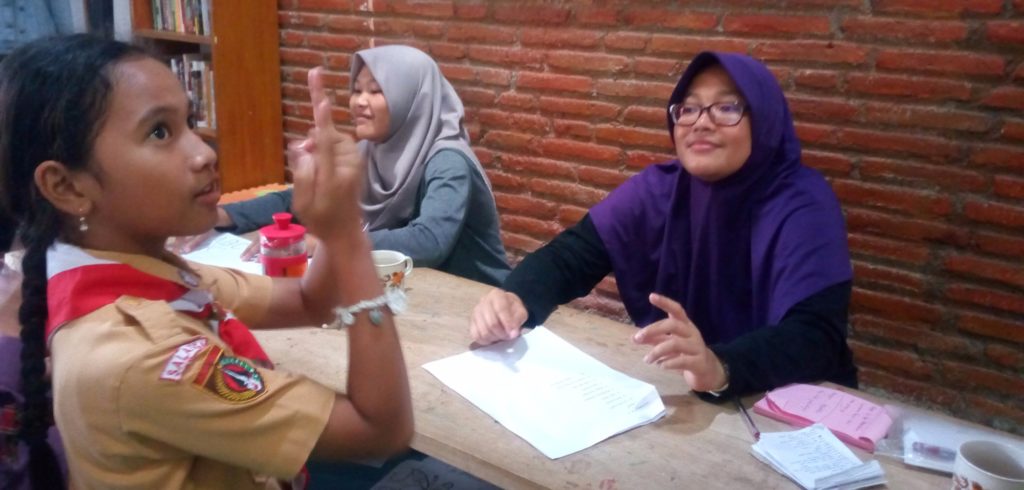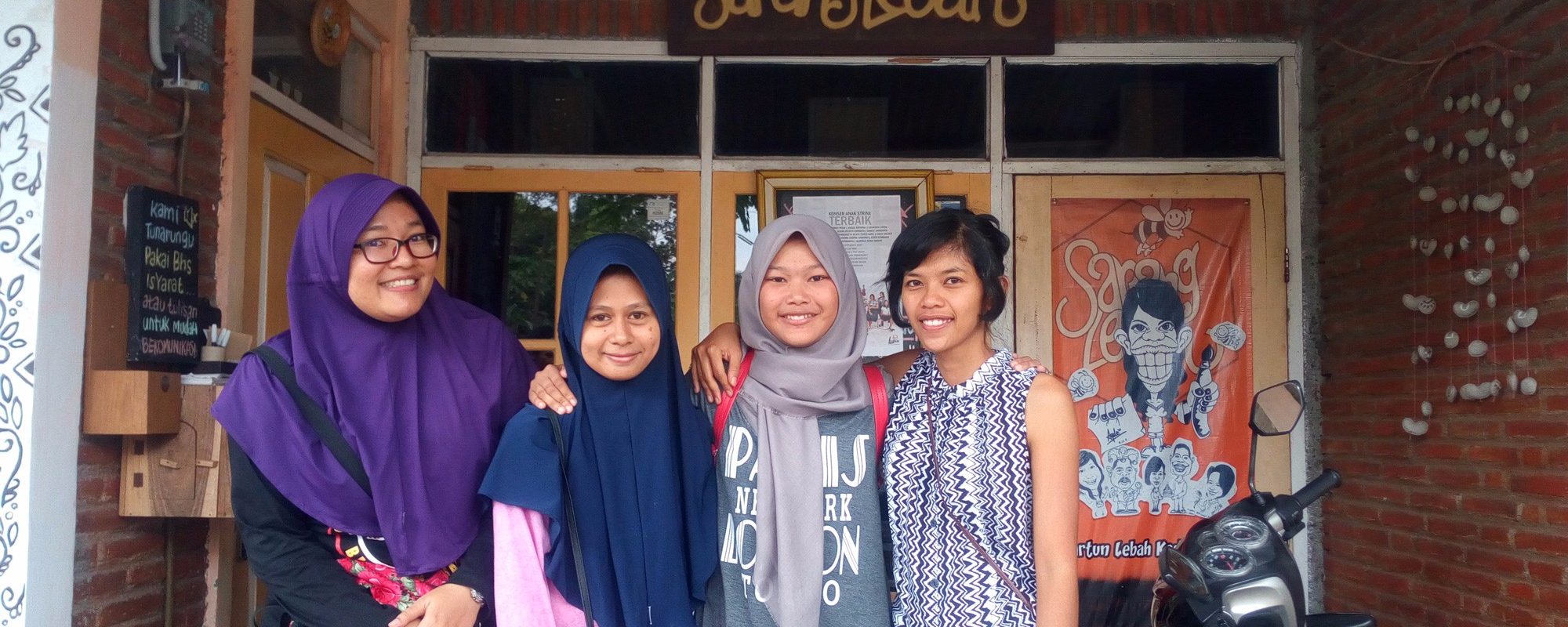SALATIGA, Indonesia — “There are 750 languages in Indonesia and ONE INDONESIAN LANGUAGE.” That message, printed on labels of Aqua water bottles, is sent out from the country’s power center of Jakarta to people in all corners of the country, from Sabang in the northwest to Merauke in the southeast.
The emphasis on Bahasa Indonesia, the country’s official language, began in 1928, when freedom fighters declared it the language of national unity. That act proved instrumental for breaking the bonds of Dutch colonialism, and the general sense is that all the archipelago’s peoples benefit from speaking a common tongue.
In pursuit of a more perfect union, the government established the Agency for the Development and Expansion of Language (BPPB; Badan Pembinaan dan Pengembangan Bahasa)[modern_footnote]All translations are my own and are as true to the authors’ intentions as the languages allow.[/modern_footnote] to publicly curate Bahasa Indonesia[modern_footnote]https://www.kompasiana.com/apose/59e054a6dd0fa810ba68ec32/peladen-untuk-padanan-server[/modern_footnote] and extend its use to all the approximately 17,500 islands that constitute the country. Not coincidentally, BPPB is also responsible for the installation of the signs detailed in my first newsletter (JVC-1) that read: “Let’s prioritize the use of the Indonesian language.” Erected throughout the outer islands, the signs perhaps inadvertently discourage the use of local languages, thereby robbing them of prestige and threatening their future.
The matter is not trivial. Of the 7,102 languages identified in the 2015 Ethnologue,[modern_footnote]https://www.ethnologue.com/endangered-languages[/modern_footnote] 707 are spoken in Indonesia. Of those, 98 are now classified as “threatened,” 28 are “nearly extinct” and 12 are no longer with us. Languages such as Hoti (from the island of Seram, near Indonesia’s storied Spice Islands) and Moksela (once spoken in the Malukus) vanished without a trace. With them went cultural knowledge and words that could potentially have helped us understand and discuss our shared reality in more nuanced ways.[modern_footnote]http://www.thejakartapost.com/youth/2016/10/24/language-endangerment-in-multilingual-indonesia.html[/modern_footnote] Nearly 10 percent of the world’s languages are spoken on lands that now belong to Indonesia, and they warrant protection. As these languages are lost and the linguasphere dwindles, the cultures that use them will fade out of existence and the vibrancy of our ethnosphere will dim.[modern_footnote]https://www.ted.com/talks/wade_davis_on_endangered_cultures[/modern_footnote]

Of course, establishing a lingua franca and encouraging its widespread use does not necessarily threaten other languages. Theoretically, there should be plenty of room for the national and local languages to coexist in a country where 77 percent of people are bilingual. But the idea of “ONE Indonesian language,” like the “common sense” behind it, is built on a number of problematic presumptions. For example, the government did create an initiative to document and preserve local languages,[modern_footnote]http://badanbahasa.kemdikbud.go.id/lamanbahasa/artikel/1823&usg=ALkJrhi5NdXrRMG8bmT7H-RfYLa6bvRefw[/modern_footnote] but then presumed the BPPB was best suited to oversee it. How can the agency tasked with establishing Bahasa Indonesia as the archipelago’s linguistic hegemon simultaneously save the languages endangered by it? Indonesian optimism aside, it can’t, and one particular language explains why.
One language
The push to prioritize “one Indonesian language” relies on a precarious presupposition: that it is even possible for all the archipelago’s peoples to speak a common tongue. Such a presumption ignores a subset of the population numbering more than two million that can’t share any spoken language because they are tuli or, more politely, tuna rungu. In English, we refer to them as deaf.
The idea that every person in Indonesia should speak the same language borders on obsession. How else can the effort to also compel deaf Indonesians to use the national language be explained?
It began in the 1990s, when the government contracted non-deaf Australian and Indonesian academics and practitioners to design a sign system that mapped onto Bahasa Indonesia, ostensibly so that teachers could speak and sign to students simultaneously.[modern_footnote]https://www.newscientist.com/article/mg14219297-700-indonesia-a-promising-sign-for-deaf-children/[/modern_footnote] And although deaf children are increasingly moved out of public schools into “extraordinary” schools for deaf, blind and slow-learning students, even at those schools, deaf children are pressured to use the Signed System of Bahasa Indonesia (SIBI) instead of Bahasa Isyarat Indonesia (BISINDO), a complete language (as opposed to a signed system) that existed before SIBI and is simpler to sign.
Signers of BISINDO thus have something in common with speakers of local languages—their languages are endangered by the government’s obsession with getting everyone to use Bahasa Indonesia, whether spoken or signed. And in an almost comical twist, they also have a common enemy—BPPB is responsible not only for developing and expanding Bahasa Indonesia, but also developing and expanding SIBI in schools from Sabang to Merauke.

SIBI or be a bee?
Every Saturday at 10 a.m., Puhan Ayu Putri opens her shop, Sarang Lebah (the Bee Hive), to anyone who wants to learn Indonesian sign language. Puhan calls the community of teachers, regulars and “newbees” who attend Sahabat Tuli, or “friends of the deaf.”
Puhan originally intended Sarang Lebah to be a tea shop until she met Dewi Setyani at a community event in their hometown of Salatiga, in central Java. Shortly after seeing Dewi’s story, she converted Sarang Lebah into a crafts studio that employs only deaf people (aside from Puhan herself) and started the Saturday sessions to teach more people in Salatiga sign language. Sahabat Tuli has been active for over six years.
Dewi, 32, received her primary and secondary education at an “extraordinary school” for deaf, blind and slow-learning students. None of her teachers knew any sign language, and Dewi says they mostly communicated orally, by writing on chalkboards and via “the kind of sign language Tarzan uses.”
Nevertheless, Dewi learned most of her sign language at school. Her parents, who are hearing people, could communicate with her only through writing and informal gestures. School was the first context in which she spent significant time with other deaf people, and it didn’t take long before the visual cues she and her new friends used to send messages evolved into a secret signaling system only they understood. Over time, Dewi and her friends augmented their code with signs they learned from deaf friends outside school.
Although Dewi and her friends didn’t realize it at the time, she now understands that most of the signs they were adopting came from BISINDO, the language championed by the Movement for the Welfare of Deaf Indonesians (Gerakan Kesejahteraan Tuna Rungu Indonesia, or GERKATIN), based in the nearby town of Solo.
“BISINDO arises from deaf culture,” Dewi tells me. “SIBI, on the other hand, is a creation of the government that uses affixes that are less appropriate.”
When I ask her for an example, she sends me the following sentences:
SIBI: “saya men-cuci piring” (“I [verb-signifier]-wash plate”)
BISINDO: “saya cuci piring” (“I wash plate”)
Although those sentences are nearly identical, Dewi notes that the verb signifier “men-” takes quite a bit of effort to sign. More important, many deaf people have no better idea of what it does or how it works than you do. Adding such verb signifiers to a signed language doesn’t add any meaningful information for non-hearing people, Dewi says.
Languages such as Hoti and Moksela vanished without a trace.
Using verb signifiers feels natural only to speakers of Bahasa Indonesia, from where they are grafted. BISINDO does not feature such signifiers, and its grammar is complicated, even compromised, by their imposition because BISINDO signers often invert sentences to add emphasis to certain words, which is harder to do when those little parts have to fall in front of the verbs to make any sense. Dewi says that’s but one example of how SIBI makes Indonesian sign language easier for hearing people at the cost of confusing the deaf. “The government does not yet understand deaf culture.”
It’s a hard charge, but it has historical backing. Dewi was nine years old when SIBI was created. Before that, oralism, or teaching deaf people to use speech and lip-read, constituted the Education Ministry’s official policy. Although the government began distributing SIBI dictionaries, using SIBI signage on public television and training teachers to learn the signed system, Dewi and most of her friends didn’t understand it and had no teachers to help them learn the language.
Perhaps unsurprisingly, most of those who grew up making their own codes and eventually adapting them to BISINDO, which now includes many regional dialects, gravitated toward GERKATIN. But the group, recognized as the organization most representative of Indonesia’s deaf people, was never even consulted or included in the design of SIBI—an insult to which another injurious fact must be added: BPPB has never employed a single deaf (or blind, for that matter) person. Needless to say, interaction between BPPB and GERKATIN—and SIBI and BISINDO—has been limited ever since.
Which brings me back to Sarang Lebah and the Saturday morning Sahabat Tuli classes Puhan and Dewi facilitate there. Although all three of Salatiga’s extraordinary schools now employ SIBI-fluent hearing teachers, there is still a lot of demand from deaf and hearing people alike for instruction in BISINDO. And over the past six years, Dewi and Puhan have established an educational space of resistance where, over tea and snacks, anyone can learn and practice Indonesia’s original, predominating sign language, be they deaf, hearing, fluent in sign or “newbees.”

Development and Expansion
BPPB’s attempt to extend Bahasa Indonesia into deaf communities has met with significant resistance from the country’s deaf people. That can be attributed to the fact that they managed to do something their hearing peers never did: organize. “Speaking” collectively via GERKATIN, they have discouraged the adoption of the government’s signed system and continued their use and popularization of BISINDO. With the help of activists like Dewi, the war for control of Indonesian sign language seems theirs to win.
When I asked Poppy Dewi Puspitawati, director of the Center for the Development and Expansion of Language Teachers and Educational Personnel, why Indonesia opted to develop a new sign system instead of using the sign language that already existed, she told me that SIBI is the “official sign language” because it is based upon EYD (Ejaan yang disempurnakan, or the perfected spelling system). That is a reference to an alteration made to Bahasa Indonesia in 1972, when the alphabetical character “oe” became “u,” “tj” became c,” “dj” became “j,” “ch” became “kh,” and “j” became “y.” According to Poppy, as long as EYD applies, SIBI is the more appropriate sign language.
Since perfecting letter-sound correspondence wouldn’t seem to warrant replacing a language, I rephrased my question. This time, her answer betrayed just a hint of the linguanationalist elitism I suspect animates the “One Indonesian language” cause.
“It is often asked whether SIBI or BISINDO are better to use,” she said. “According to teachers who understand all this, both should be learned by teachers and deaf students. They say that SIBI uses formal Bahasa Indonesia whereas BISINDO is simple and tends to be used for slang.”
That’s the logic according to teachers who are, almost without exception, hearing people. But what about deaf people, their organization GERKATIN or their language, BISINDO? To what extent does BPPB involve them in its efforts?
“The Indonesian government has never banned BISINDO. Feel free to use it, if it is indeed easier,” Poppy suggested. “But it should be noted that BISINDO is a social language that is so reliant on context that it varies from village to village.”
The statement reminded me of the messages sent out on signs and waterbottles to all the country’s distant spaces. Standardize. Even though languages are human creations, and even English varies from country to country, city to city and peer group to peer group, the obsession with ONE Indonesian language disregards that simple truth in an onward march to unify the people of the nation in similitude.
Unity in Diversity
Indonesia’s national motto is “Bhineka Tunggal Ika,” Sanskrit for “United in Diversity.” It is similar to the motto of the United States: “E Pluribus Unum,” Latin for “From many, one.” I have often pointed out the similarity to friends in Indonesia and America to highlight just how similar our nations are.
But in writing this article, it occurs to me that the two phrases are just a bit different. Although America has no official language, it often seems it does. From the many people who have immigrated to America over the past couple centuries, most have adopted the English language in an attempt to assimilate. From many, ONE language.
Compare that to Indonesia, which does have an official language: Bahasa Indonesia. Here, the central government’s efforts to develop and expand the language build on discourses about independence and “unity in diversity,” but actually all the people of the archipelago have been here much longer than Indonesia has existed. The use of schools to force-educate the nation’s children, be they deaf or distant, out of their grandparents’ languages and cultures is evidently ethnonationalist. The inculcation of “Indonesianity” presupposes a diminishing of regional identities. The construction of a national identity had a similar effect on the cultures of native people throughout the colonies of England, France, Spain and Portugal.
It occurs to me that languages often take the names of countries and carry with them a historical legacy of colonialism. The language of England now predominates in over 50 countries, there are 29 countries that speak French, Spanish is the official language in 20 countries and another 10 countries have adopted Portuguese as a common tongue. While the tendency is not as pronounced, the world’s signed languages are also nationally inflected.
But in Indonesia, a country formed in the post-colonial era, we see the hegemonizing of language directed not outward, but inward. Over the coming decades, it is inevitable that scores of languages will die here, regardless of calls by academics to save the ethnosphere. Before 1945, many of the freedom fighters in this archipelago would have called that a form of colonialism and resisted it tooth and nail. Now, nothing.
So I am left to wonder: if language is a metaphorical key to culture, what will happen to the worldviews and ways of life if the local languages that align with them are lost? Will the efforts to establish “ONE Indonesian language” ultimately succeed in locking us out of the archipelago’s prized diversity, of the robustness that gives humanity its strength? If BPPB and the Indonesian government continue on as they have for the past 72 years, we all may end up with just a few big doors and a drawer full of keys that don’t open anything.

